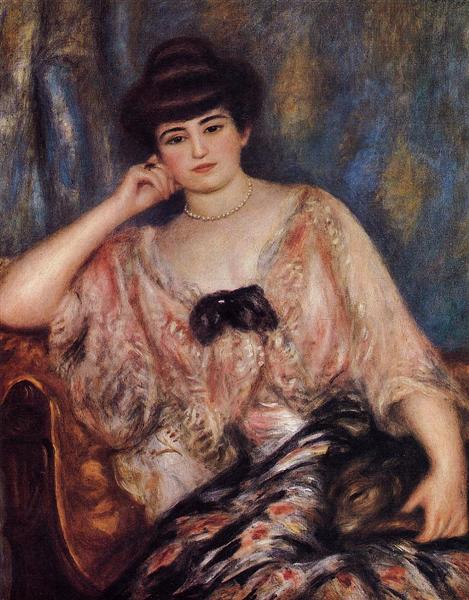Description
L'œuvre "Misia - 1904" de Pierre -Auguste Renoir est érigée comme un chef-d'œuvre qui résume l'essence du portrait au début du 20e siècle, à un moment où l'impressionnisme était déjà en pleine évolution vers de nouvelles formes d'expression. Misia Sert, le surnom de "Reine de l'art", était une figure centrale du monde culturel parisien et de la muse de nombreux artistes, et sa représentation de Renoir reflète non seulement sa beauté et sa sophistication, mais devient également un véhicule pour explorer le lien entre le Artiste et son modèle.
Dans cette peinture, Renoir présente Misia dans un portrait doux qui met en évidence non seulement sa personnalité, mais aussi son environnement. La composition est remarquablement équilibrée, avec un fond qui, bien que diffuse, suggère une atmosphère intime et confortable. L'utilisation d'une palette riche, prédominante par des tons chauds et terribles, crée une atmosphère enveloppante. Renoir utilise une utilisation magistrale de la couleur pour capturer la luminosité naturelle dans la peau du Minsive et dans ses vêtements. Ses tons dorés et son miel sur le visage contrastent délicatement avec les éléments les plus sombres de l'arrière-plan, ce qui fait briller Misia de vitalité.
Le portrait, qui montre Misia avec une expression sereine et contemplative, reflète le style caractéristique de Renoir, où la capture de la nature était toujours au premier plan. Le regard de Misia pénètre, invitant le spectateur à entrer dans ses pensées. Cheveux foncés et lumineux, soigneusement ombragés, encadre son visage, tandis que la robe noire offre une touche d'élégance qui met en évidence sa silhouette. Cette utilisation du noir est particulièrement importante, car non seulement offre un contraste visuel, mais symbolise également le sens de la formalité et du statut que Misia possédait dans sa circonscription sociale et artistique.
Le traitement de la lumière dans le travail est un autre aspect qui mérite d'être mentionné. Renoir est connu pour sa capacité sur la représentation de l'effet de la lumière sur différentes surfaces, et "Misia - 1904" ne fait pas exception. La lumière semble glisser doucement sur la peau du Missie, accentuant ses caractéristiques avec une douceur qui va au-delà du simple réalisme. La lumière brille en arrière-plan, suggérant un environnement brillant et éthéré qui contraste avec la solidité de la figure centrale.
Misia, dont la présence dans l'art était séminale, a collaboré avec des artistes renommés et a joué un rôle crucial en tant que critique de critique et d'art. Renoir, qui l'a dépeint à plusieurs reprises, réalise dans ce travail synthétiser la connexion personnelle et professionnelle qui existait entre eux. Ce portrait, dans un contexte plus large, est également inséré dans la tradition du portrait féminin dans la peinture, où l'artiste cherche non seulement à représenter la personne, mais aussi à raconter une histoire plus profonde sur l'identité et le rôle des femmes dans la société.
L'œuvre fait partie de la hauteur de la carrière de Renoir, qui avait développé son style depuis le début de l'impressionnisme vers une plus grande simplification et une approche plus intime de ses sujets. Alors que Renoir s'éloignait du coup de pinceau rapide et lâche qui avait caractérisé ses premières œuvres, "Misia - 1904" montre un plus grand raffinage à la fois dans la technique et dans la conception du portrait.
En bref, "Misia - 1904" est plus qu'un simple portrait; C'est un dialogue entre l'artiste et sa muse, le reflet de l'époque et un témoignage du statut Missy dans le monde de l'art. L'œuvre est un excellent exemple de la façon dont Renoir parvient à fusionner la technique et l'émotion, nous invitant à entrer un moment de l'histoire dans laquelle la peinture n'était pas seulement une représentation visuelle, mais un véhicule de connexion humaine et culturelle.
KUADROS ©, une peinture célèbre sur votre mur.
Peintures à l'huile fabriquées à la main, avec la qualité des artistes professionnels et le sceau distinctif de KUADROS ©.
Service de reproduction des images avec garantie de satisfaction. Si vous n'êtes pas complètement satisfait de la réplique de votre peinture, nous remboursons votre argent à 100%.

